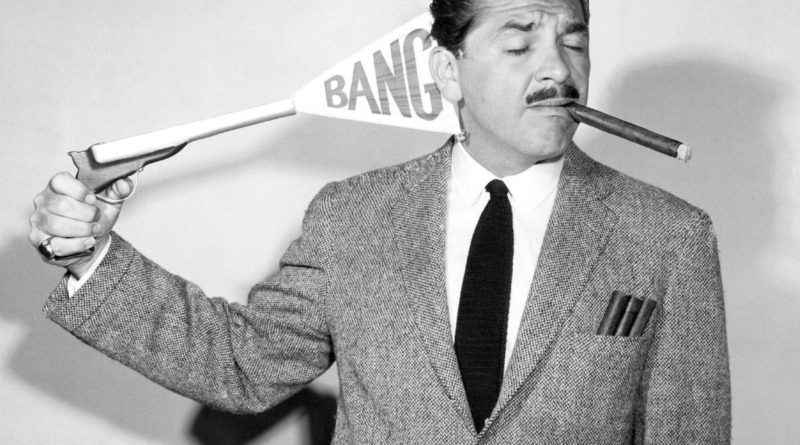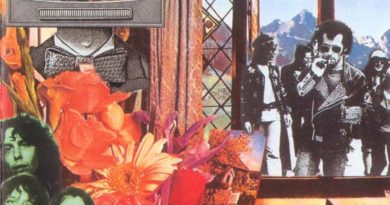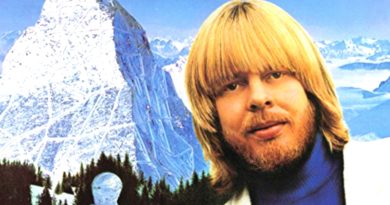Televisionary: Josh Mills Discusses Comedy Pioneer Ernie Kovacs
The reissue of his classic comedy album celebrates the centennial of the television legend

There was no precedent for the comedy of Ernie Kovacs. A pioneering figure in the early days of television, Kovacs brought a bizarre kind of comedy – mostly verbal, but with a visual component as well – to the black-and-white screens of the 1950s.
A half century-plus later, his material is still bizarre. Recently, Omnivore Recordings worked with Josh Mills – son of Kovacs’ widow Edie Adams, a TV star in her own right – to reissue a 1970s-era compilation of some of Ernie Kovacs’ most memorable bits. The new CD (The Ernie Kovacs Album: Centennial Edition) collects those and adds some additional material that Mills found while digging through the family archives. Though he never knew Kovacs – the TV star died many years before he was born – Mills is the foremost scholar/expert on Kovacs’ legacy and body of work.
Even though Ernie Kovacs has long had a reputation of visual comedy, these pieces – originally broadcast on television – work without the visual component, almost as if they were designed to be audio only. Did he consciously develop material that was designed to work with or without visuals, or was it just part of his particular genius that they worked that way?
Very interesting question. Because while I don’t know if he initially thought of these particular bits as stand-alone audio pieces, he had been on radio for years. So, there definitely is a part of him that was trying to tell a story without visuals. And I’m sure there is some connection between the two. There were times in Ernie’s career when he was employed, then not employed, then employed, then not employed. And frequently, when he was not on television, he was on radio. We found a bunch of acetates of radio airchecks, and on those we can hear skits and things that he didn’t do on television. So, I’m sure there was a connection somewhere.
There’s such an off-the-wall character to these things that they almost feel like stream-of-consciousness. But to my mind, there’s absolutely no way they could be. Because the stories hold together; you might not realize it until the end, but he knew where he was going with each one from the start, through the middle, to the end … even if we don’t. Did he routine this stuff? Or did he ever do any sort of traditional standup comedy?
No. In fact, my mom was always saying that Ernie was so out-there; his whole idea wasn’t from Vaudeville or standup or performing onstage. Just theater stuff in school and things like that. But his was purely off-the-cuff, top-of-the-head type of wackiness. One of his quotes was that, “Some of my best material is when it’s 15 minutes before air and I’ve gotta come up with something.”

He did think improvisationally or extemporaneously, almost in a jazz kind of way. Often it went very well and sometimes it went completely off the rails. And it’s actually kind of fun when it doesn’t do well because, then, Ernie kind of makes these weird comments about stuff. He’s incredibly relaxed for the pressure of whatever radio show or television show he was on right then. He’s totally relaxed. So, I think some of the stuff might have even been last minute kind of things that he threw together.
His wordplay is often very sophisticated. It’s hard to imagine that all of that stuff would have landed with audiences of the day. Some of it, I imagine, probably went over their head. I suppose they were just caught up in the sheer weirdness of it … ?
For years, he was a columnist for a paper in his hometown of Trenton, New Jersey called The Trentonian. So he definitely wrote well because he did it for many years even before he went on radio. I have poems that he wrote and things like that that are very erudite; they’re super weird and dark. It’s really weird stuff.
We have scripts of Ernie’s that will say, “Ernie improvises for 10 minutes,” and then it’ll go on to the next part. It was literally like, “We don’t know what he’s gonna say, but we have to type something up and this is what everybody’s going to get. Ernie’s just going to talk.” So, I think that that kind of stuff either came from the top of his head or through his experience as a columnist at The Trentonian.
One of the first things I thought of when I was listening – especially that very first piece on the original album, the “Tom Swift” piece – was Firesign Theater. Even though he predates them by many years, I wouldn’t be at all surprised that he was an influence on them. Although, I’ve never read specifically anywhere that that’s the case. Do you know of anybody in any medium who has gone on record as saying that he influenced their work?
Oh, yeah. I mean, specifically I don’t know about the Firesign Theater. Specifically, Joel Hodgson from Mystery Science Theater 3000. Terry Gilliam from Monty Python has said some really nice things about Ernie. Paul Reubens’ Peewee Herman character, for sure. Kids in the Hall.
And everybody asks about Letterman. Letterman says he was more of a fan of Steve Allen, but the writers for the original Late Night with David Letterman were fans of Ernie’s. I think that a lot of things like Stupid Dog Tricks and weird things like that got on the air because it was a very Ernie thing to do. The throwing the pencil at the camera and breaking the fourth wall, that was very Ernie. So, there’s a ton of different people.
When the first box set came out, I sent a mailing out to John Stewart and Jimmy Kimmel just so they had it. And I got a really nice note back from Jimmy Kimmel on his letterhead: “I’m a huge fan, and my grandfather and I used to watch him together. I have such great memories, and your mom was amazing.” I thought that was really cool that he actually took the time and wrote me a personal handwritten letter.
VIDEO: The Best of Ernie Kovacs — Ernie Kovacs on Music with an intro by Jack Lemmon
My first exposure to Kovacs was the PBS retrospective series, which I guess was in the late ’70s.
Yeah. This record came out in ’76. It was nominated for a Grammy in ‘77 for Comedy Album of the Year. And then, the same year, ‘77, PBS showed The Best of Kovacs, which really was where 90% of the people that I talk to remember Kovacs from. I’ll get notes – Jon Spencer from Jon Spencer Blues Explosion basically told me, “I was a kid in New Hampshire and I didn’t know what the hell I was watching, but this was great. My dad sat me down and we watched it.” So, a lot of different people.
I mean, it’s really random. I’ve talked to Gerry Casale from Devo; he’s a big fan. Chris Stein and Debbie Harry from Blondie are both big fans. So his influence is not just comedically, but I think he has such a cockeyed way of looking at things that kind of musicians who went to on some fame kind of gravitated towards him as well.
What do you think Ernie Kovacs’ lasting legacy is?
I’m not disparaging Milton Berle or Jackie Gleason or anyone, but unlike most of his contemporaries, I think Ernie really figured out the medium of television before anyone. And he’s still way, way ahead of the pack. Television was starting in the late ’40s and Ernie was starting in the early ’50s; there was no drawing board. He just created it. And how did he know that these things would work? I mean, there’s no way that you could actually have tried that out. Like I said, he wasn’t in Vaudeville, and he didn’t do standup. But creatively, he figured out ways that it did work. So, I think the fact that he was unencumbered with any sort of history let the canvas sort of open up. He could paint whatever he wanted to, because he had this weird idea in his head. And he could pull it off somehow.
This is purely speculative. If he Kovacs had modern technology at his disposal, what do you think he would’ve done with it?
I think in the ’80s and ’90s, the laptop computer would’ve blown his mind. I think he would’ve been working with that medium. I also think that he probably, at this point, would have his own thing outside of the networks or outside of television where he could just do it on his own, whether it was like a video blog or whether it was programming on YouTube or something like that.
He was notoriously – what’s the right word? – he didn’t like interference and network executives. No one should tell him what was funny and what wasn’t funny, what was going to work and what wasn’t going to work. So, I think he would’ve found a medium where he basically controlled everything and didn’t have to listen to anybody saying, “There’s no punchline, Ernie. I don’t get it.” So, I think he’d be doing something on his own.
In recent years, there have been quite a number of Kovacs-related projects that you’re responsible for. There’s the Percy Dovetonsils picture disc, and the Centennial Edition DVD box set, the Take a Good Look box set, and so on. Will there be more?
Yes, in fact, next year in 2020. Pat Thomas and I put together an Ernie Kovacs coffee table book. Basically, what I started to notice was that a lot of the things that I was finding in our archive – and frankly even some things I bought on eBay because I couldn’t find them – were articles he wrote for magazines. Usually, “men’s magazines,” so to speak. And they haven’t been seen since they were originally published. We also found a chapter of a book that Ernie started before he passed away. We found another book that’s never been published, and we’re taking chapters and all these unpublished things and putting them around all this great ephemera and weird visual stuff that we have in our archive. So it’ll be a really cool deep dive into everything, from his drawings to newspaper articles to credit cards and his entrance card to Aqueduct RaceTrack … a bunch of weird things. So, that’s coming.
And by the way, I’ll throw this out there. We did find 120 hours of audio-only material. So, whether that’s something for Sirius radio or another audio release or a podcast or something like that, we’re going to figure out what to do with those next.
And this year, on August 7, at the National Comedy Center in Jamestown, New York – which is the birthplace of Lucille Ball – they’re having an Ernie Kovacs centennial exhibition. It will have physical item and different stuff from our collection that’s going to be on display in the museum for the whole year.
It’s nice after kind of a drought of many, many years that all this stuff is coming to light now. So how, when, and why you did you become involved in the curation and preservation of Ernie Kovacs’ work?
When my mom passed away in 2008, I became the executor of both her estate and Ernie’s estate. Everything that was under her control is now mine. So I had to figure out a way to get this stuff to market. And luckily, Shout!Factory is and was a great partner and they wanted to do some stuff, and Omnivore Recordings was great and wanted to do some stuff with us with audio. I also put out a DVD set of my mom’s [Here’s Edie: The Edie Adams Television Collection]. It was really a little bit of a cottage industry that I kind of started to create.
Ernie died in ‘62, and now it’s 2019. We’re closing on 60 years. It’s a long time. So I want to make sure that this stuff gets out there.
VIDEO: The Ernie Kovacs Album




